Abstract
Public response to energy projects affects the emergence of new technologies and the distribution of their risks and benefits. Here we use thousands of individually authored comments submitted during a regulatory review of unconventional shale gas development in New York State to reconcile previous, inconsistent results about the relationship between proximity and opposition to energy projects. We find that members of the public opposed unconventional shale gas development for different reasons, which varied systematically with proximity to unconventional gas wells. Public discourse in proximate communities was diverse, invoking environmental, social, economic and political impacts, and was anchored by concerns specific to a particular place. By contrast, a few nationally salient environmental concerns dominated public discourse in communities farther from development. Our results demonstrate that public response reflects the mobilization of alternative constituencies with unique understandings of the issue. Distinguishing among these is critical for understanding the nature of public response.
Access options
Subscribe to Journal
Get full journal access for 1 year
99,51 €
only 8,29 € per issue
Tax calculation will be finalised during checkout.
Rent or Buy article
Get time limited or full article access on ReadCube.
from$8.99
All prices are NET prices.
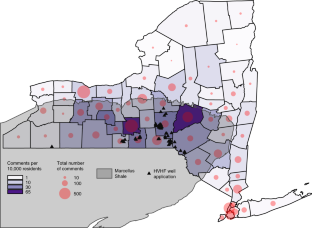
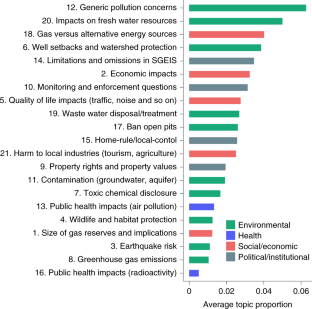
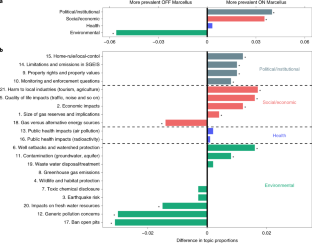
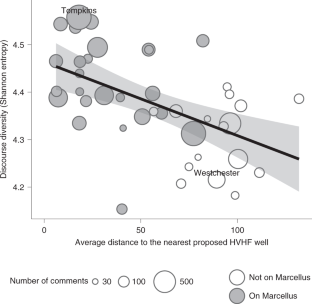
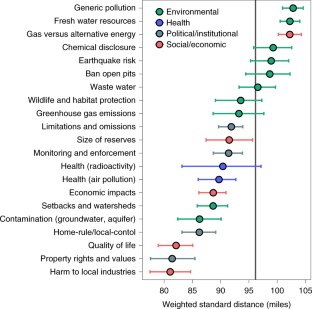
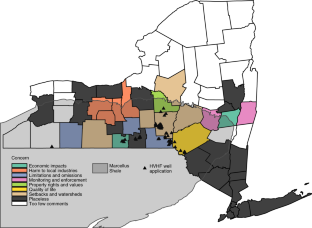
Data availability
The original public comments data are part of the public record and available freely from the New York State Department of Environmental Conservation through a public records request (https://www.dec.ny.gov/public/373.html). Because the full records include personally identifiable information (names, addresses and emails), they are not shared in a public repository by the author. Comment data that exclude personal identifiers are, however, available from the author upon reasonable request for replication and research purposes. Also, processed datasets, which allow the replication of the statistical analyses but exclude the raw comment data, are available online at https://doi.org/10.7910/DVN/XHSVTN.
Code availability
R code for replicating all statistical analyses can be accessed online at https://doi.org/10.7910/DVN/XHSVTN.
References
- 1.
Boudet, H. S. Public perceptions of and responses to new energy technologies. Nat. Energy 4, 446–455 (2019).
- 2.
Boudet, H. et al. ‘Fracking’ controversy and communication: using national survey data to understand public perceptions of hydraulic fracturing. Energy Policy 65, 57–67 (2014).
- 3.
Brasier, K. J. et al. ‘Residents’ perceptions of community and environmental impacts from development of natural gas in the Marcellus Shale: a comparison of Pennsylvania and New York cases. J. Rural Soc. Sci. 26, 32–61 (2011).
- 4.
Davis, C. & Jonathan, M. F. Energy abundance or environmental worries? Analyzing public support for fracking in the United States. Rev. Policy Res. 31, 1–16 (2014).
- 5.
Jackson, R. B. et al. The environmental costs and benefits of fracking. Annu. Rev. Environ. Resour. 39, 327–362 (2014).
- 6.
Neville, K. J. et al. Debating unconventional energy: social, political, and economic implications. Annu. Rev. Environ. Resour. 42, 241–266 (2017).
- 7.
Ellis, C., Gene, L. T., Petrzelka, P., Jackson-Smith, D. & Luloff, A. E. Unconventional risks: the experience of acute energy development in the Eagle Ford Shale. Energy Res. Soc. Sci. 20, 91–98 (2016).
- 8.
Jacquet, J. Review of risks to communities from shale energy development. Environ. Sci. Technol. 48, 8321–8333 (2014).
- 9.
Thomas, M., Partridge, T., Harthorn, B. H. & Pidgeon, N. Deliberating the perceived risks, benefits, and societal implications of shale gas and oil extraction by hydraulic fracturing in the US and UK. Nat. Energy 2, 17054 (2017).
- 10.
Alcorn, J., Rupp, J. & Graham, J. D. Attitudes toward “fracking”: perceived and actual geographic proximity. Rev. Policy Res. 34, 504–536 (2017).
- 11.
Boudet, H., Zanocco, C. M., Howe, P. D. & Clarke, C. The effect of proximity to unconventionl oil and gas development on public support for hydraulic fracturing. Risk Anal. 38, 1871–1890 (2018).
- 12.
Clarke, C. E. et al. How geographic distance and political ideology interact to influence public perception of unconventional oil/natural gas development. Energy Policy 97, 301–309 (2016).
- 13.
Gravelle, T. B. & Lachapelle, E. Politics, proximity and the pipeline: mapping public attitudes toward Keystone XL. Energy Policy 83, 99–108 (2015).
- 14.
Junod, A. N., Jeffrey, B. J., Fernando, F. & Flage, L. Life in the Goldilocks Zone: perceptions of place disruption on the periphery of the Bakken Shale. Soc. Nat. Resour. 31, 200–217 (2018).
- 15.
Konisky, D. M., Ansolabehere, S. & Carley, S. Proximity, NIMBYism, and public support for energy infrastructure. Public Opin. Q. 82, 391–418 (2020).
- 16.
Chad, Z., Boudet, H., Clarke, C. E. & Howe, P. D. Spatial discontinuities in support for hydraulic fracturing: searching for a “Goldilocks Zone”. Soc. Nat. Resour. 32, 1065–1072 (2019).
- 17.
Esaiasson, P. NIMBYism—a re-examination of the phenomenon. Soc. Sci. Res. 48, 185–195 (2014).
- 18.
Krause, R. M. et al. Not in (or under) my backyard: geographic proximity and public acceptance of carbon capture storage faclities. Risk Anal. 34, 529–540 (2014).
- 19.
Swofford, J. & Slattery, M. Public attitudes of win energy in Texas: local communities in close proximity to wind farms and their effect on decision-making. Energy Policy 38, 2509–2519 (2010).
- 20.
Jenkins-Smith, H. C., Carol, L. S., Nowlin, M. C. & deLozier, G. Reversing nuclear opposition: evolving public acceptance of a permanent nuclear waste disposal facility. Risk Anal. 31, 629–644 (2011).
- 21.
Kristy, M., Carlisle, J. & Smith, E. Nimbyism vs. environmentalism in attitudes toward energy development. Environ. Politics 17, 20–39 (2008).
- 22.
Batel, S. & Devine-Wright, P. Towards a better understanding of people’s responses to renewable energy technologies: insights from social representations theory. Public Underst. Sci. 24, 311–325 (2015).
- 23.
Geraint, E., Barry, J. & Robinson, C. Many ways to say ‘no’, different ways to say ‘yes’: applying Q-Methodology to understand public acceptance of wind farm proposals. J. Environ. Plan. Manag. 50, 517–551 (2007).
- 24.
Evensen, D. & Richard, C. S. Scale matters: variation in perceptions of shale gas development across national, state, and local levels. Energy Res. Soc. Sci. 20, 14–21 (2016).
- 25.
Benford, R. D. & David, A. S. Framing processes and social movements: an overview and assessment. Annu. Rev. Sociol. 26, 611–639 (2000).
- 26.
Chong, D. & James, N. D. Framing theory. Annu. Rev. Political Sci. 10, 103–126 (2007).
- 27.
Moscovici, S. Social Representations: Explorations in Social Psychology (New York Univ. Press, 2001).
- 28.
Bugden, D., Evensen, D. & Stedman, R. A drill by any other name: social representations, framing, and legacies of natural resource extraction in the fracking industry. Energy Res. Soc. Sci. 29, 62–71 (2017).
- 29.
Devine-Wright, P. Rethinking NIMBYism: the role of place attachment and place identity in explaining place-protective action. J. Community Appl. Soc. Psychol. 19, 426–441 (2009).
- 30.
Evensen, D., Clarke, C. & Stedman, R. A New York or Pennylvania state of mind: social representations in newspaper coverage of gas development in the Marcellus Shale. J. Environ. Stud. Sci. 4, 65–77 (2014).
- 31.
Schafft, K. A., Borlu, Y. & Glenna, L. The relationship between Marcellus Shale gas development in Pennsylvania and local perceptions of risk and opportunity. Rural Sociol. 78, 143–166 (2013).
- 32.
Gamson, W. A. Talking Politics (Cambridge Univ. Press, 1992).
- 33.
McAdam, D. & Boudet, H. Putting Social Movements in their Place: Explaining Opposition to Energy Projects in the United States, 2000–2005 (Cambridge Univ.Press, 2012).
- 34.
Ashmoore, O., Evensen, D., Clarke, C., Krakower, J. & Simon, J. Regional newspaper coverage of shale gas development across Ohio, New York, and Pennsylvania: similarities, differences, and lessons. Energy Res. Soc. Sci. 11, 119–132 (2016).
- 35.
Arnold, G., Farrer, B. & Holahan, R. How do landowners learn about high-volume hydraulic fracturing? A survey of eastern Ohio landowners in active or proposed drilling units. Energy Policy 114, 455–464 (2018).
- 36.
Farrell, J. The Battle for Yellowstone: Morality and the Sacred Roots of Environmental Conflict (Princeton Univ. Press, 2015).
- 37.
Bell, S. E. Fighting King Coal: the Challenges to Micromobilization in Central Appalachia (MIT Press, 2016).
- 38.
Kojola, E. Who speaks for the place? Cultural dynamics of conflicts over hazardous industrial development. Sociol. Forum 35, 673–695 (2020).
- 39.
Lawlor, A. & Timothy, B. Framing trans-border energy transportation: the case of Keystone XL. Environ. Politics 27, 666–685 (2018).
- 40.
Freudenburg, W. R. & Grambling, R. Oil in Troubled Waters: Perceptions, Politics, and the Battle over Offshore Oil (State Univ. of New York Press, 1994).
- 41.
Evensen, D., Jeffrey, B. J., Clarke, C. E. & Stedman, R. C. What’s the ‘fracking’ problem? One word can’t say it all. Extr. Ind. Soc. 1, 130–136 (2014).
- 42.
Farrell, J. Corporate funding and ideological polarization about climate change. Proc. Natl Acad. Sci. USA 113, 92–97 (2016).
- 43.
Perrin, A. J. & McFarland, K. Social theory and public opinion. Annu. Rev. Sociol. 37, 87–107 (2011).
- 44.
Mazur, A. How did the fracking controversy emerge in the period 2010-2012? Public Underst. Sci. 25, 207–222 (2016).
- 45.
Wilber, T. Under the Surface: Fracking Fortunes and the Fate of the Marcellus Shale (Cornell Univ. Press, 2012).
- 46.
Blei, D. M. Probabilistic topic models. Commun. ACM 55, 77–84 (2012).
- 47.
Vasi, I. B., Walker, E., Johnson, J. & Tan, H. F. “No fracking way!” Documentary film, discursive opportunity, and local opposition against hydraulic fracturing in the United States, 2010 to 2013. Am. Sociol. Rev. 80, 934–959 (2015).
- 48.
Cunningham, S. The story of an emerging energy issue: national television news coverage of fracking in the United States. Environ. Commun. 13, 804–819 (2019).
- 49.
Hammer, R., Levine, L. & Van Briesen, J. In Fracking’s Wake: New Rules are Needed to Protect Our Health and Environment from Contaminated Wastewater. Report no. D:12-05-A (Natural Resources Defense Council, 2012).https://www.nrdc.org/sites/default/files/Fracking-Wastewater-FullReport.pdf
- 50.
Dokshin, F. A. Whose backyard and what’s at issue? Spatial and ideological dynamics of local opposition to hydraulic fracturing in New York, 2010 to 2013. Am. Sociol. Rev. 81, 921–948 (2016).
- 51.
Kraft, M. C. & Clary, B. B. Citizen participation and the NIMBY syndrome. West. Political Q. 44, 299–328 (1991).
- 52.
Dokshin, F. A. NIMBYs and partisans: how material interests and partisanship shape public response to shale gas development. Environ. Politics 29, 390–413 (2020).
- 53.
Grimmer, J. & Brandon, M. S. Text as data: the promise and pitfalls of automatic content analysis methods for political texts. Political Anal. 21, 267–297 (2013).
- 54.
Roberts, M. E. et al. Structural topic models for open-ended survey responses. Am. J. Political Sci. 58, 1064–1082 (2014).
- 55.
Boyd-Graber, J., Mimno, D. & Newman, D. in Handbook of Mixed Membership Models and Their Applications (eds Airoldi, E. M., Blei, D., Erosheva, E. A. & Fienberg, S. E.) Ch. 12 (CRC Press, 2014).
- 56.
DiMaggio, P., Nag, M. & Blei, D. Exploiting affinities between topic modeling and the sociological perspective on culture: application to newspaper coverage of US government arts funding. Poetics 41, 570–606 (2013).
- 57.
Sievert, C. & Shirley, K. in Proceedings of the Workshop on Interactive Language Learning, Visualization, and Interfaces (eds Chuang, J., Green, S., Hearst, M., Heer, J., Koehn P.) 63–70 (Association for Computational Linguistics, 2014).
- 58.
Engelder, T. Marcellus 2008: report card on the breakout year for gas production in Appalachian Basin. Fort Worth Basin Oil and Gas Magazine 19–22 (2009).
- 59.
Munger, K., Bonneau, R., Nagler, J. & Tucker, J. A. Elites tweet to get feet off the streets: measuring regime social media strategies during protest. Political Sci. Res. Methods 7, 815–834 (2019).
Acknowledgements
I thank D. Bugden, A. Eads and S. Hazboun for valuable comments. I gratefully acknowledge support for this study from the National Science Foundation (award no. SES-161602248).
Author information
Affiliations
Contributions
F.A.D. designed and performed the research, analysed the data and wrote the paper.
Corresponding author
Ethics declarations
Competing interests
The author declares no competing interests.
Additional information
Peer review information Nature Energy thanks Hilary Boudet, Darrick Evensen and the other, anonymous, reviewer(s) for their contribution to the peer review of this work.
Publisher’s note Springer Nature remains neutral with regard to jurisdictional claims in published maps and institutional affiliations.
Supplementary information
Supplementary Information
Supplementary Notes 1–3, figures and tables.
Rights and permissions
About this article
Cite this article
Dokshin, F.A. Variation of public discourse about the impacts of fracking with geographic scale and proximity to proposed development. Nat Energy (2021). https://ift.tt/3tENpWE
-
Received:
-
Accepted:
-
Published:
"discourse" - Google News
September 13, 2021 at 10:06PM
https://ift.tt/3nsvl0E
Variation of public discourse about the impacts of fracking with geographic scale and proximity to proposed development - Nature.com
"discourse" - Google News
https://ift.tt/2KZL2bm
https://ift.tt/2z7DUH4
No comments:
Post a Comment